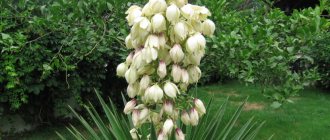Violets and Saintpaulias
Saintpaulia, popular among gardeners, actually has nothing to do with the flowers of the Violet family.
They were discovered by accident in the 90s of the 19th century by the military commandant of the Uzambara district of the German colony in East Africa. It was Baron Walter von Saintpaul. In his honor, the plant received its specific name - Saintpaulia. The seeds sent to Germany sprouted, and the plant was soon described by naturalist Hermann Wendland as Saintpaulia violet-flowered (or violet-flowered). There is indeed a resemblance between Saintpaulias and violets, but only externally. An African plant with flowers similar to violets began to spread in Europe. Without going into details of the classification, amateur flower growers very quickly began to call it “violet”.
Description of varieties
“LE-Lilac Rain” is a variegated variety with large double flowers of a soft lilac color and fancy dark purple streaks. The diameter of the flowers can vary from 4.5 to 5.5 cm. The leaves are large, uniformly emerald in color with light beige wavy edges. The sockets are characterized by extraordinary compactness and accuracy. The variety is easy to care for.
“LE-Lilac Tenderness” is an unpretentious variety that produces large and lush lilac-white or white-pink star-shaped flowers. The fleshy, succulent leaves have a slightly pointed tip. The color of the leaves is uniform, emerald or dark green.
“Lilac Charm” is an elegant Saintpaulia with large fringed flowers of a pale lilac color and a thin rich purple edging. A characteristic feature is 3 purple markings located in the center of the flower. The leaves have a regular round shape and slightly wavy edges. The variety is very decorative, characterized by abundant and surprisingly long flowering.
“N-Lilac Smiley” is a beautifully flowering Saintpaulia with large, fringed, amethyst-colored flowers with a bright white edge. The rounded leaves are deep dark green on the outside and reddish on the inside. Peduncles form en masse in the center of a compact rosette.
“RS-Lilac Miracle” is a very spectacular Saintpaulia variety that produces large double flowers of a pale purple color and a lightened edge. The diameter of the flowers can reach 7 centimeters. The leaves are simple, round in shape and uniformly green in color. The diameter of the rosette is about 25 centimeters. The variety is considered very unpretentious, easy to care for and reproduce.
“Lilac Excitement” is an elegant Uzambara violet with very large fringed flowers. The two-color petals combine dark purple and pale purple shades, harmonizing well with the dark emerald foliage. The leaves on the inside are reddish in color.
“PT-Lilac Distance” is an original variety with large single or semi-double flowers. The petals are light amethyst in color with deep purple shading on the wavy edges. The plant forms a neat rosette of variegated leaves with a dark emerald core and a light beige uneven edge.
“Lilac Sand” is a variety of Uzambara violet that has an original and spectacular color. The peculiarity of the plant is its simple pale pink large flowers, dotted with a scattering of small dark purple splashes and framed by an edging of the same shade. The leaves have a classic oval shape and color ranging from pale green to a uniform dark emerald hue.
“Lilac Mist” is an Uzambara violet that forms a beautiful and compact rosette of emerald succulent leaves with jagged edges. During the flowering period, it forms multiple peduncles located in the center of the rosette. The color of the flowers varies from pale amethyst to purple. The ruffled petals have intricate wavy edges. The variety is considered demanding of care; if the rules are not followed, the plant stops blooming.
“Lilac watercolor” is a very spectacular variety, notable for its large, voluminous flowers of pale amethyst color with white spots shifted to the edge or to the center of the petals. The beautiful blurred transition from white to light purple creates a striking contrast against the dark green velvet leaves.
“AV-Purple Elephant” is a relatively young variety that forms a large number of buds during the flowering period. Very large double flowers are collected in thick, voluminous clusters. The color of the petals is a uniform and rich indigo color with an elegant white edging at the edges.
“Lilac Charm” is an unusually beautiful variety, valued by flower growers for its impressive decorative properties. The flowers of this Uzambara violet can be either double or semi-double. The highlight of the variety is the amazing color of the petals - tiny and numerous lilac-raspberry splashes on a delicate pearl pink background. It is noteworthy that closer to the edges of the petals the spray thickens, turning into a beautiful dark lilac edging.
“KO-Lilac Paradise” is an amazingly beautiful variety of Saintpaulias, distinguished by a proportional compact rosette. During the flowering period, a lush cap of flowers of a delicate amethyst color is formed in the center of the rosette. A light snow-white border is allowed on the petals. The leaves have regular rounded outlines, wavy edges and a slightly pointed tip.
Features of cultivation
To ensure optimal conditions for the development of violets, you should provide it with proper lighting, protect it from drafts, and do not forget about irrigation and the introduction of nutrients. Saintpaulia will be able to bloom for nine and a half months a year, including winter. In summer, flowering is likely to be interrupted, since excessively high temperatures interfere with it. The soil mixture for “Whipped Cream” can be easily purchased at the store or you can make it yourself. Saintpaulia will like the combination of turf, coniferous soil, sand and leaf soil, taken in equal parts. Before use, the mixture will have to be disinfected: either kept in the freezer for a whole day, or heated in an oven heated to 200 degrees for an hour.
The soil for violets should be saturated with useful substances, loose and permeable to both air and moisture. You should not enrich it with rotted manure, as this will activate the growth of green mass instead of promoting flowering. To choose the most successful pot, you need to measure the diameter of the outlet - the capacity should be 3 times larger than the indicator. There must be drainage holes to ensure drainage of liquid after irrigation.
Lighting should be in moderation, since the violet will suffer both in the case of direct exposure to sunlight and when located in a darkened space. In the cold season, the flower feels great on the windowsills of windows facing south, but in the summer it will have to be moved to windows facing north. To create the diffused lighting that Saintpaulia likes, you can place fabric or white paper between the glass and the plant itself. The violet will need 10 to 12 hours of daylight, but during the flowering period it is a good idea to provide additional lighting. It is recommended to move the flower pot 90 degrees twice a week. This action will make it possible to achieve uniformity in the development of the leaf rosette.
In the summer, the optimal temperature is between 24 and 26 degrees, and in winter, “Whipped Cream” can be grown at 18 degrees. Air humidity should be at least 50%, but it is strictly not recommended to spray it to increase it, as this threatens the appearance of ugly brown spots.
When planting a plant in a pot, you must first create a drainage layer, the thickness of which is 2 centimeters. Next, a small amount of soil is poured on top, and the seedlings themselves are placed. The soil mixture is laid out in a circle on top, and everything is carefully slammed down.
Caring for a plant at home
Saintpaulia requires attention, but novice gardeners, if they follow all care recommendations , will be able to:
- Grow a beautiful symmetrical rosette;
- And achieve cap flowering.
Saintpaulia requires proper care.
Conditions of detention
At home, the Uzambara violet feels good both on the windowsill and when kept on illuminated shelves.
Proper watering and fertilizing
The substrate should always be slightly moist ; the earthen clod should not be allowed to dry out, but the violet also does not like overflowing.
Tips for watering:
- Water the violet with warm, settled water;
- Between waterings, the top layer of soil should dry out slightly;
- Keep the substrate slightly moist at all times;
- Do not use hard water for irrigation;
- A strong flood of violets will lead to rotting of the root system.
Violets, which are generous with flowers require nutrition all year round ; for this purpose, fertilizing is carried out along with watering. During flowering, violets are fed with complex fertilizer regularly with each watering. And in winter, during dormancy, fertilizers are applied once a month.
In winter, she also needs feeding, because her energy consumption is at the same level all the time. It is still advised to move the violet to a darker and cooler place from December to February (but not lower than 15°C) so that the flower gains strength before the New Year.
Lighting and temperature
The “Crimean Spring” variety can withstand fluctuations in room temperature, but the favorable temperature will be 18-24 °C.
If the room temperature is higher or lower than this mark, then the plant slows down , and when it is hot, the beautiful symmetrical rosette begins to thicken the center.
In winter, Saintpaulia requires additional lighting.
For year-round flowering of violets, it is necessary to maintain the length of daylight hours, it should be at least 10-12 hours .
Attention! The lighting must be turned off at night, otherwise the plant will be depleted.
Air humidity
Violets tolerate low humidity well, but experience discomfort, which will affect the quality of flowering . If the humidity in the room is low, you must:
- Monitor regular watering;
- And do not allow the substrate to dry out.
Too high humidity is also detrimental to Saintpaulia , the plant begins to be attacked by various fungal diseases.
Advice! To increase humidity, you can use an automatic humidifier or place the flower in a tray with wet expanded clay or pebbles.
What kind of soil does he prefer?
The soil for violets is used as loose and light as possible . Flower growers plant the plant in a prepared substrate. To do this, mix:
- High peat, with perlite;
- Vermiculite for loosening the soil;
- Or they use foam balls, which also prevent the earthen clod from compacting.
Soil for violets can be bought at a flower shop.
Pruning and hygiene
The formation of a Saintpaulia rosette begins at the “baby” stage. All curved, irregularly shaped leaves are removed from the young plant . In an adult plant, unnecessary stepsons are cut off, which every now and then strive to appear inside the leaf axils.
Reproduction methods
for propagating this variety of Uzambara violet is cuttings . To obtain a varietal plant with the best qualities, a cutting is taken from the second row of leaves, from under the peduncle with all the characteristics of the variety.
When propagated by leaf cuttings from the mother rosette, varietal characteristics are not always transmitted . Of several children, some may be of the sports variety.
also propagated by stepsons , while the daughter rosette retains all the varietal characteristics of the mother variety.
Transplant rules, rejuvenation
The young Saintpaulia is replanted when the roots of the plant entwine the entire earthen ball and it becomes cramped in the pot. They use the transshipment method for this, preserving the earth clod as much as possible.
An adult Saintpaulia is rejuvenated after two to three years , when the trunk becomes bare. For rejuvenation, the trunk and crown are cut off, cleaned and placed to take root in new nutritious soil.
Important! For quick rooting, use a greenhouse.
Saintpaulia needs to be replanted once a year.
Once every six months, Saintpaulia is transplanted into fresh soil , the soil is changed after every second flowering. This way you can monitor the root system and remove old dead roots when replanting.
Well, almost black violet Dark Night of The Soul
Speaking of almost black varieties, it is impossible to ignore the Dark Night of The Soul variety.
A beautiful, even, symmetrical rosette, semi-miniature in size, which forms independently. The leaves are variegated, rounded, and quite large. A special feature of the variety are spoon-shaped leaves, the edges curl slightly upward. The color of the leaves is variegated, medium green with white.
The flowers are wine-black, double pansies with a coral-red underside. In bud, the half-opened flower is almost black, but as it opens it acquires a red, rather beet-like, hue.
Important! This variety is the only one bred by McDonald outside the Mac's series.
Violet LIK-Rustle of Waves (G. Lazarenko)
LIK-Rustle of Waves belongs to the genus of hybrid Saintpaulias from the Gesneriev class. Bred by breeder G. Lazarenko .
Wonderful violet Rustle of Waves.
The rosette is of standard size, slightly loose, due to slightly elongated petioles on the leaves. The color of the sheets is quite dark , with a red underside. The shape is round with teeth, the edge is very wavy.
Attention! The leaves are very juicy and fragile, even a light, careless touch can damage it.
The flowers are large, double, with thick ruffles along the edges of the petals. The color is blue, more saturated on the front part , and almost white on the back and along the edge of the petal. Flowering is abundant and caplike. Starting from the first, the buds carry 3-5 buds and under their weight can lie on the leaves.
Not a single grower has registered sports for this variety , but this does not exclude the possibility of their occurrence.
Reproduction of such Saintpaulias
To preserve the mother color of the plant, the usual method of propagation by cuttings is not suitable in the case of chimera violets.
The following methods allow you to maintain the desired color:
- Reproduction using peduncles. At their base there is a dormant bud, from which, when carefully cut and rooted, a new shoot grows. He will eventually become a new violet.
- The upper part of the plant, along with flowers and one row of leaves, is completely cut off and planted in the ground. To avoid excessive evaporation of moisture, before roots appear, it is covered with film or glass containers to create greenhouse conditions.
- Rooting by stepchildren. To do this, the topmost shoot is cut off. After some time, lateral layers appear at the site of the break. These cuttings can be plucked and planted in the ground.
Features of flowering, growth and reproduction
The rosette develops very well and quite quickly . A plant can be considered an adult at the age of 12-13 months. It blooms for the first time a year, sometimes a little earlier.
Peduncles are long and weak and usually cannot support the weight of the buds .
The abundance of flowering is immediately striking; a large head of flowers rests lightly along the edges of the leaves. Usually there are 3-5 buds on a peduncle, which bloom gradually and last quite a long time.
In general, flowering lasts several weeks . Flowers are little affected by temperature; they slightly change shade, but nothing more.
Important! The variety is not whimsical in propagation; any of the methods gives a stable good number of children.
Most often, leaf cuttings and stepsons are used, and flower stalks do not take root so confidently, and therefore are used only to strengthen unusual flowering.











